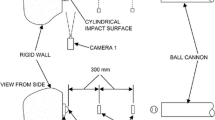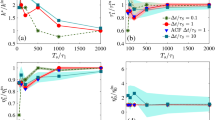Abstract
The trajectory of a ball impacting with an angle on a rigid boundary is recorded with a high-speed camera and the dynamics is reconstructed in a computer. Several experiments are carried out in order to obtain statistical distributions of the trajectory. On the other hand, a continuum model of a viscoelastic material ball simulates the experiment. If the values of the constitutive parameters (e.g. elastic and viscous modulus, friction coefficient, etc.) in the numerical model are correct, the simulated dynamics and the experimental data should match. In this study, the Bayesian inference is applied to identify two constitutive parameters (the friction and viscous coefficients) through statistical measures. The methodology shows to provide a useful tool to solve an inverse problem with a stochastic approach which allows to reference the results in a statistic frame starting from indirect and sparse information.












Similar content being viewed by others
References
Larson, R.G.: The Structure and Rheology of Complex Fluids. Oxford University Press, New York (1999)
Popov, V.L.: Contact Mechanics and Friction—Physical Principles and Applications. Springer, New York (2010)
Johnson, K.L.: Contact Mechanics. Cambridge University Press, New York (1987)
Stronge, W.J., Ashcroft, A.D.: Oblique impact of inflated balls at large deflections. Int. J. Impact Eng. 34(6), 1003 (2007). https://doi.org/10.1016/j.ijimpeng.2006.04.006
Burley, M., Campbell, J.E., Dean, J., Clyne, T.W.: Johnson–Cook parameter evaluation from ballistic impact data via iterative FEM modelling. Int. J. Impact Eng. 112, 180 (2018). https://doi.org/10.1016/j.ijimpeng.2017.10.012
Nikoofard, H., Farahani, S.V., Jafari, G.R.: Dependence of the friction coefficient between two rough surfaces on their reciprocal correlation function. Physica B Condens. Matter 452, 71 (2014). https://doi.org/10.1016/j.physb.2014.07.011
Palasantzas, G.: Influence of self-affine surface roughness on the friction coefficient for rubbers. J. Appl. Phys. 94(9), 5652 (2003). https://doi.org/10.1063/1.1635812
Persson, B.N.J.: Theory of rubber friction and contact mechanics. J. Chem. Phys. 115(8), 3840 (2001). https://doi.org/10.1063/1.1388626
Vuoristo, T., Kuokkala, V.T., Keskinen, E.: Dynamic compression testing of particle-reinforced polymer roll cover materials. Compos. Part A Appl. Sci. Manuf. 31, 815 (2000). https://doi.org/10.1016/S1359-835X(00)00030-0
Rosales, M.B., Filipich, C.P., Buezas, F.S.: Crack detection in beam-like structures. Eng. Struct. 31(10), 2257 (2009). https://doi.org/10.1016/j.engstruct.2009.04.007
Buezas, F.S., Rosales, M.B., Filipich, C.P.: Damage detection with genetic algorithms taking into account a crack contact model. Eng. Fract. Mech. 78(4), 695 (2011). https://doi.org/10.1016/j.engfracmech.2010.11.008
Kaipio, J., Somersalo, E.: Statistical and Computational Inverse Problems—Applied Mathematical Sciences, vol. 160, 1st edn. Springer, New York (2006). https://doi.org/10.1007/b138659
Beck, J.L., Yuen, K.V.: Model selection using response measurements: Bayesian probabilistic approach. J. Eng. Mech. 130(2), 192 (2004). https://doi.org/10.1061/(ASCE)0733-9399(2004)130:2(192)
Toni, T., Welch, D., Strelkowa, N., Ipsen, A., Stumpf, M.P.H.: Approximate Bayesian computation scheme for parameter inference and model selection in dynamical systems. J. R. Soc. Interface 6(31), 187 (2009). https://doi.org/10.1098/rsif.2008.0172
Ritto, T.G., Nunes, L.C.S.: Bayesian model selection of hyperelastic models for simple and pure shear at large deformations. Comput. Struct. 156, 101 (2015). https://doi.org/10.1016/j.compstruc.2015.04.008
Alvin, K.: Finite element model update via Bayesian estimation and minimization of dynamic residuals. AIAA J. 35(5), 879 (1997)
Rappel, H., Beex, L.A., Bordas, S.P.: Bayesian inference to identify parameters in viscoelasticity. Mech. Time Depend. Mater. 22(2), 221 (2018)
Patelli, E., Govers, Y., Broggi, M., Gomes, H.M., Link, M., Mottershead, J.E.: Sensitivity or Bayesian model updating: a comparison of techniques using the DLR AIRMOD test data. Arch. Appl. Mech. 87(5), 905 (2017)
Rappel, H., Beex, L.A., Hale, J.S., Noels, L., Bordas, S.: A tutorial on Bayesian inference to identify material parameters in solid mechanics. Arch. Comput. Methods Eng. 385, 27–361 (2020)
Haario, H., Von Hertzen, R., Karttunen, A.T., Jorkama, M.: Identification of the viscoelastic parameters of a polymer model by the aid of a MCMC method. Mech. Res. Commun. 61, 1 (2014). https://doi.org/10.1016/j.mechrescom.2014.07.002
PDE Solutions Inc. FlexPDE (2009)
Gurtin, M.E., Fried, E., Anand, L.: The Mechanics and Thermodynamics of Continua. Cambridge University Press, Cambridge (2010)
Cendra, H., Grillo, S.: Generalized nonholonomic mechanics, servomechanisms and related brackets. J. Math. Phys. 47(2), 022902 (2006). https://doi.org/10.1063/1.2165797
Wriggers, P.: Computational Contact Mechanics, 2nd edn. Springer, New York (2006). https://doi.org/10.1007/978-3-540-32609-0
Amontons, G.: Memoires de L’Academie Royale des sciences, pp. 206–227 (1699)
Coulomb, C.A.: Theorie des machines simples: en ayant egard au frottement de leurs parties ete la roideur des cordages. Bachelier, Paris (1821)
Brown, D.: Tracker video analysis and modeling tool. V 4.91. http://www.opensourcephysics.org (2015)
MATLAB: version 7.10.0 (R2010a), The MathWorks Inc., Natick, Massachusetts (2010)
Gear, C.W.: Simultaneous numerical solution of differential-algebraic equations. IEEE Trans. Circuit Theory 18(1), 89 (1971). https://doi.org/10.1109/TCT.1971.1083221
Acknowledgements
This study was funded by Secretaría General de Ciencia y Tecnología, Universidad Nacional del Sur (Grant Number 24/J075); FONCyT, Agencia Nacional de Promoción Científica y Tecnológica (Grant Number PICT-2015-0220); CONICET (Grant Number 112 201301 00007 CO), all institutions from Argentina. The authors would like to thank B. Marron and L. Quinzani (from UNS-CONICET institutions) for providing information in the Bayes results interpretations and rheological measures.
Author information
Authors and Affiliations
Corresponding author
Additional information
Publisher's Note
Springer Nature remains neutral with regard to jurisdictional claims in published maps and institutional affiliations.
Appendices
Appendix A Weak formulation
In order to solve the equations of motion, they are rewritten in their weak form. Let \(\mathbf {W}\) be a test vector field (the admissible functions) of variables referred to the body in its material configuration. Multiplying the equations of motion by \(\mathbf {W}\) and integrating over all domain \(V_{0}\):
where Eq. 16 is obtained after integrating Eq. 15 by parts (using Green’s formula). The surface integral is divided into two parts, \(\varGamma ^{1}\) and \(\varGamma ^{2}\). Suppose that the position vector \(\mathbf {x}\) is prescribed in a part of the boundary’s surface \(\varGamma ^{1}\), where the geometrical boundary conditions are imposed \(\varGamma ^{1}=\varGamma _{D}\), and the traction is given at the other part (\(\varGamma ^{2}=\varGamma _{F}+\varGamma _{C}\).) With this scheme, the Robin boundary condition corresponds to a natural one. Then:
In the case of non-homogeneous essential (geometrical) boundary conditions, the solution \(\mathbf {x}(\mathbf {X},t)\) must satisfy Eq. 17 on \(\varGamma ^{1}\) but the test function \(\mathbf {W}\) must satisfy the homogeneous essential boundary condition. Then, in the variational problem Eq. 16, the admissible test functions \(\mathbf {W}\) are defined as
and the solution \(\mathbf {x(X)}\)
with this, the natural boundary conditions in Eq. 16 are automatically imposed. Then, the surface integral in Eq. 16 reduces to
where \(\bar{\mathbf {t}_{R}}\) is the value (data) of the traction \(\mathbf {t_{R}}\) in the boundary. In the case of a bouncing ball, the traction vectors are null on the external body surface \(\varGamma _{F}\) with exception of the contact surface \(\varGamma _{C}\). On the other hand, the part \(\varGamma _{D}\) is not presented in this scheme because it corresponds to the prescribed motion \(\varGamma ^{1}\), not imposed in this problem.
Finally, the variational problem consists in finding the vector \(\mathbf {x(X,}t)\), implicit in \(\mathbf {T}_{\mathbf {R}}\) via constitutive equation, such that
and the initial conditions,
where \(\mathbf {v(X)}\) is the known initial velocity field. These initial conditions are taken through the experimental data i.e. the average values of incidence angle (\(\theta _{i}\)), spin and speed (\(v_{i}\)), taken from the 55 samples of the impact test.
Appendix B Galerkin method and discretization in finite elements
Let \(\left\{ \mathbf {\phi _{j}}\right\} \in Adm_{1}\) be a basis of a subspace of a Hilbert space. In this paper \(\mathbf {\phi }_{\mathbf {i}}\) are shape vector functions and each component is a 3-dimensional quadratic polynomial. Let the function \(\mathbf {x}(\mathbf {X},t)\) be expanded in a series of the this vectorial functions \(\mathbf {\phi _{i}(X)}\)
Here \(c_{i}(t)\) are functions only of time.
Replacing Eq. 23 in Eq. 1 and integrating on the whole domain:
for j from 1 to n. \(\mathbf {T_{R}(x)}\) means that the first Piola stress tensor is calculated from \(\mathbf {x}(\mathbf {X},t)\) through constitutive relations Eq. 4 and definition of the second Piola stress. At last, using Eq. 16 we get:
where \(V_{j}\) is the volume of the jth element.
This numerical calculation is made in the environment of the FlexPDE version 7 software [21].
Rights and permissions
About this article
Cite this article
Buezas, F.S., Fochesatto, N., Rosales, M.B. et al. Bayesian inference of constitutive parameters from video data of the impact dynamics of a ball. Arch Appl Mech 90, 1795–1810 (2020). https://doi.org/10.1007/s00419-020-01697-0
Received:
Accepted:
Published:
Issue Date:
DOI: https://doi.org/10.1007/s00419-020-01697-0




